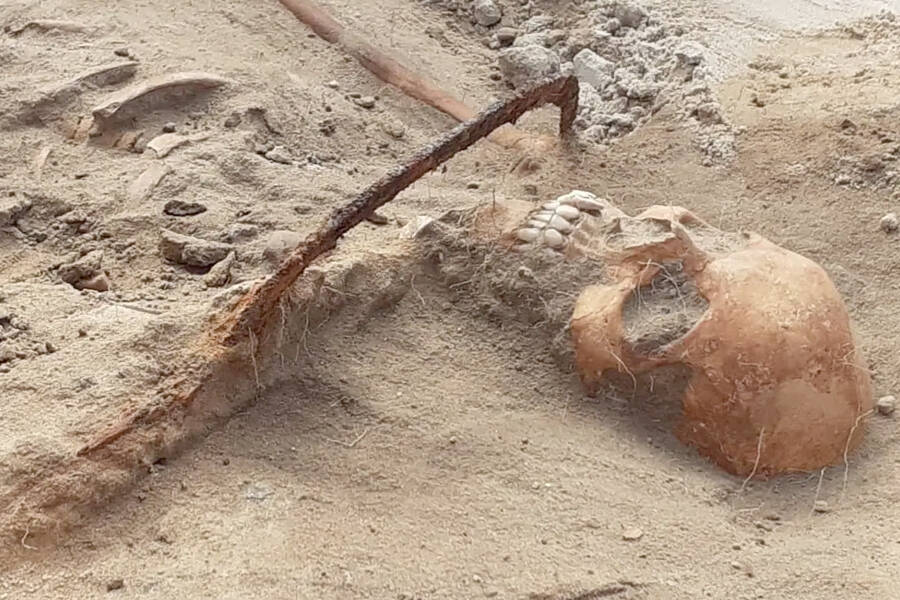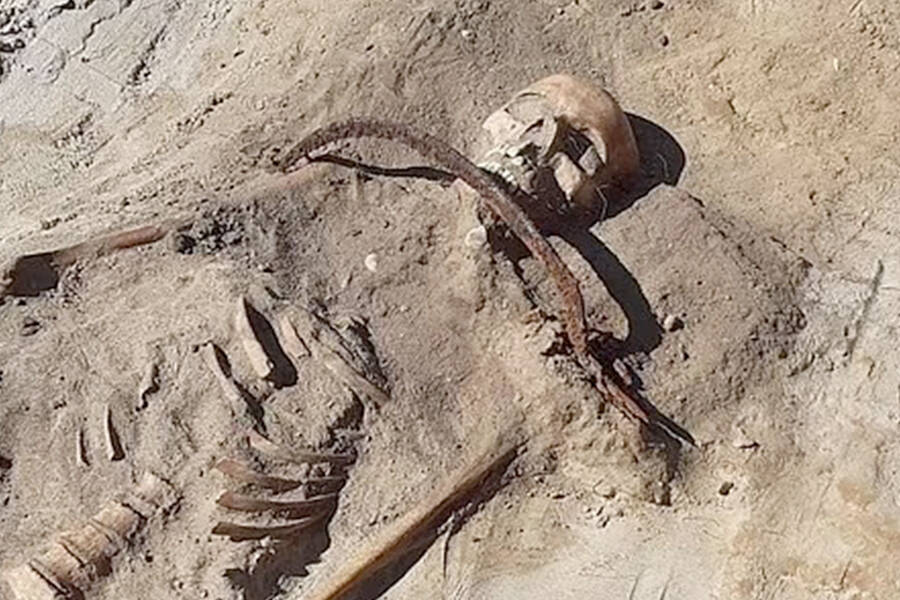The skeleton was discovered in Pień, Poland with a sickle across her throat and a padlock on her toe.

Miroslav Blicharski/AlexsanderDuring a time known as the “18th-Century Vampire Controversy,” superstition surrounding vampires peaked in Eastern Europe, leading to countless deaths and odd burials.
Archaeologists working at a site near Pień, Poland recently unearthed a fascinating relic of Eastern Europe’s vampire panic in the 17th and 18th century. In a small graveyard, they found a woman’s body that had been buried with a sickle placed across her neck and a padlock on the toe of her left foot.
As Heritage Daily reports, alleged reports of vampires reached their peak in Europe the 18th century — along with exhumations and stakings.
This specific grave dates to sometime in the 17th century, before the fear of vampires reached a fever pitch. However, it’s clear to experts that whoever buried the unidentified woman did their best to make sure she wouldn’t come back from the dead.
Nicolaus Copernicus University Professor Dariusz Poliński explained that, based on how the body and sickle were positioned, the intent was likely to decapitate the woman if she tried to rise from the grave to terrorize the living.
“The sickle was not laid flat but placed on the neck in such a way that if the deceased had tried to get up most likely the head would have been cut off or injured,” Poliński told Daily Mail.
Records of undead myths in Eastern Europe date back as far as the 11th century, but in some regions, the myths were so widely believed that they caused hysteria among the people. This led to many accusations of vampirism against those who died in an untimely fashion — particularly by suicide.
This hysteria became so prominent that by the end of the 17th century, all across Poland, odd burial practices were being put into place in response to an “outbreak” of vampires, with many bodies being mutilated posthumously.

Miroslav Blicharski/AlexsanderSome experts believe that the skeleton’s protruding teeth may have been what marked the woman as a vampire or witch in life.
“Other ways to protect against the return of the dead include cutting off the head or legs, placing the deceased face down to bite into the ground, burning them, and smashing them with a stone,” Poliński said.
Curiously, the female vampire discovered by the team from Nicolaus Copernicus University also had a silk hat on her head — a luxury commodity in the 17th century. It indicates that she likely had a high social status in her community.
This further supports more recent theories that people who had been labeled “vampires” during this period were not strangers or newcomers to towns who garnered suspicion and distrust from locals. Rather, they were locals themselves.
A similar discovery in the northwestern region of Poland several years ago also offers some more insight into how and why residents conducted these bizarre burials.
Per Smithsonian Magazine, in 2014, researchers discovered six other skeletons, each with a sickle placed over its body, in a gravesite in northwestern Poland.
After conducting a biogeochemical analysis of the bones, they made a startling discovery: the six “vampires” had all been from the area and not, as previously believed, strangers of whom the local townsfolk would have been wary.
“These individuals were not suspected of becoming vampires due to their identity as non-locals, but instead, were distrusted within some other, additional societal context as members of the local community,” the researchers reported at the time.

Miroslav Blicharski/AlexsanderOther burial sites throughout Poland have revealed similar remains, some with sickles around their throats and others with sickles around their waists.
It is difficult for researchers to identify what the source of that distrust may have been, but the study’s lead author, Lesley Gregoricka, theorized that the vampire label may have been given to the first victims of cholera epidemics that were common throughout Europe at the time.
“People of the post-medieval period did not understand how disease was spread,” Gregoricka said, “and rather than a scientific explanation for these epidemics, cholera and the deaths that resulted from it were explained by the supernatural — in this case, vampires.”
These same supernatural explanations also serve as the justification for the placement of the sickle around the bodies of the deceased. Yes, they were put in place to protect the living from the undead, but they also served as a way to protect the deceased from evil forces.
“According to folk wisdom, a sickle protected women in labor, children, and the dead against evil spirits,” researchers told Daily Mail. “It also had a role in rituals designed to counter black magic and witchcraft.”
The new female vampire skeleton has been sent to the university in Toruń for further archaeological study.
After reading about the discovery of a female “vampire” skeleton in Poland, learn about the other feared creature that caused medieval villagers to mutilate their dead: zombies. Then, discover the story of the ancient Roman child who was subjected to a “vampire burial” to prevent him from returning from the dead.





